Saturday, November 15, 2003
Billon antoninianus, Göbl MIR 36, 850b
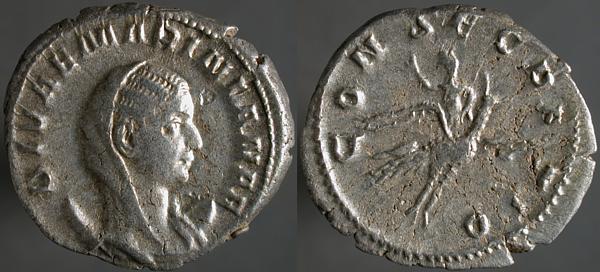
Minted at Viminacium. DIVAE MARINIANAE, Veiled draped bust right on crescent / CONSECRATIO, Mariniana on peacock flying right. Mariniana was the wife of Valerian and mother of Gallienus. All coins in her name are posthumous, so it's assumed she died prior to Valerian's accession in 260 CE. Valerian did not honor any subsequent wife, I know of no evidence that he remarried. Virtually nothing is known about Mariniana.
Friday, November 14, 2003
Æ tetradrachm, Alexandria, Valerian, Emmett 3705(5)
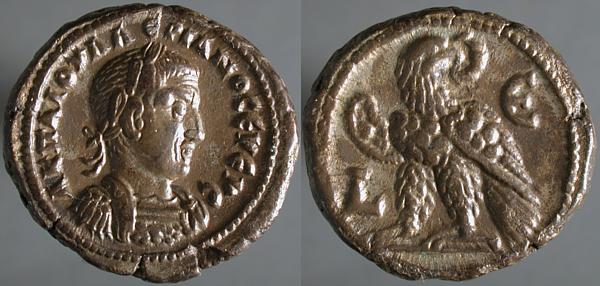
Æ tetradrachm. Α Κ Π ΛΙ ΟVΑΛΕΡΙΑΝΟC ΕVΕVC, Laureate cuirassed bust right /L_Ε, Eagle standing left, head right, wreath in beak. Regnal year across fields.
Coins of Roman Egypt are explicitly dated, unlike imperial issues as I mentioned on Sunday. The Egyptian dating uses (alphabetic) Greek Numerals, counting the years of the Emperor's reign, with each year starting at the end of August. (Commodus counted his reign from the beginning of his father's reign, but Commodus was one of those people that has to do things differently.)
The precise origins of the L symbol in the dates aren't understood, but it is occasionally replaced with ΕΤΟΥC ("of the year") and clearly has the same meaning.
Roman Egypt maintained a closed monetary system from the time of Augustus through the time of Diocletian, when it began minting, and using, imperial coins.
Thursday, November 13, 2003
Counterfeit Æ antoninianus, c.f. Göbl MIR 36, 1640c
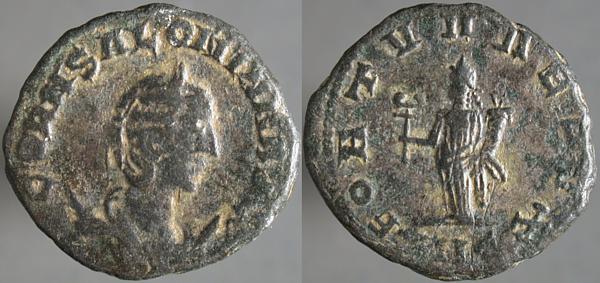
counterfeit antoninianus CORN SALONINA AVG, Diademed draped bust right on crescent / FORTVNA RDVX, Fortuna standing facing, head left, holding cornucopia right and cauduceus left. VIIC· in exergue.
All sorts of ancient imitations of ancient coins exist. This one is convincing at first glance, but a closer look shows a great many things that aren't right.
The obverse legend is a valid one for Salonina, although the letter forms seem a little off. The hair-style on the bust looks good, but the face doesn't. Here's an authentic CORN SALONINA AVG obverse from Antioch, the only mint that used the VIIC· mark, which indicated that Gallienus was Consul for the 7th time.
The reverse legend is missing a letter, and the letter forms again look off: the T is far too broad for the height and the serifs are too prominent, most clearly on the X. The figure of Fortuna seems off-style, too, particularly the arm holding the cauduceus. Here's an authentic reverse of that type, from Antioch.
A little research only makes it more clear that this isn't official mint product. The only legend that Antioch was using for Salonina by the time of the VIIC coins was SALONINA AVG, and it never issued any FORTVNA REDVX coins in her name.
Any one of these problems might be explained away as a mint error, or a previously unknown coin, but that seems impossible for one coin with so many details wrong.
Wednesday, November 12, 2003
Æ Sextans, Roman Republic, Sear 610, 217-215 BCE
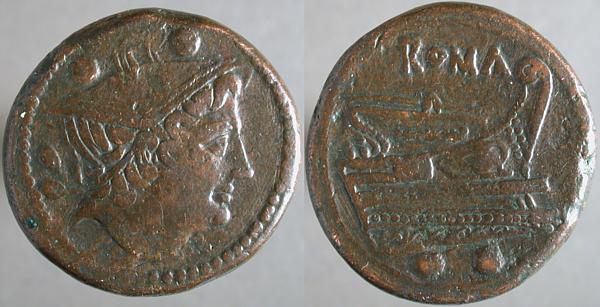
Head of Mercury right, wearing winged petasus, two pellets above / Prow right, ROMA above, two pellets beneath.
The consuls for 215 were Lucius Postumius Albinus and Tiberius Sempronius Gracchus, father of Tiberius and Gaius Gracchus. In that year, Ptolemy V Epiphanes came to the throne of Hellenistic Egypt.
At this time coins of the Roman republic were quite standardized, each denomination looking largely the same each year, and bearing no indication of the annual moneyor. In time, the coins gave more information about the moneyor, until in the late republic it was common practice to portray a famous ancestor on the obverse and to name the family on the reverse.
Shortly before Julius Caesar was assassinated, coins were issued bearing his name and image, an assault on Republican traditions that sought to keep one man from rising above all others.
Tuesday, November 11, 2003
Billon antoninianus, Göbl MIR 36, 1441k
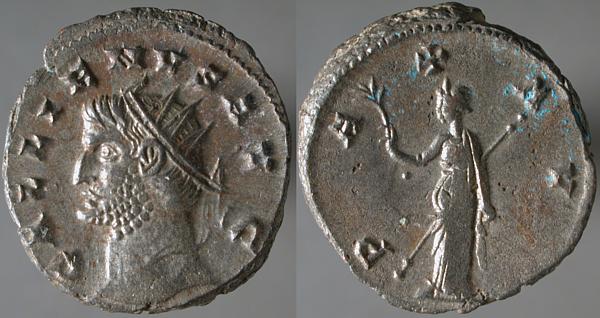
Göbl does not attest this bust for this reverse. GALLIENVS AVG, Radiate head left / PAX AVG, Pax standing facing, head left, holding branch left and long scepter transverse. Mint of Siscia.
The standard English-language reference for imperial coins of Gallienus, Roman Imperial Coinage volume V part I, was published in 1927 and has had only typographical corrections since. While it may seem surprising that 75 years should make much difference in looking at coins that are about 1,750 years old, they've been 75 years full of discovery and rethinking.
The best book for these coins, at present is Austrian-published Moneta Imperii Romani 36, 43, 44 - Die Münzprägung der Kaiser Valerianus I, / Gallienus / Saloninus, Regalianus und Macrianus / Quietus. by the late Robert Göbl. The text is all in German, but the attribution charts are clear and easy to use with only the rarest need to use translation tools.
Despite the many years of work that went into this posthumously-published book, unattested varieties can be found. This coin, purchased on eBay in September, is one of those rare items.
Because the demand for Gallienus coins is quite low, even they can be had for very reasonable prices. While you should collect what interests you, when choosing between things that interest you, there can be merit in selecting one that interests others less.
Collecting for investment would dictate a different set of choices.
Monday, November 10, 2003
Æ29, Syedra in Cilicia, Lindgren III, 909
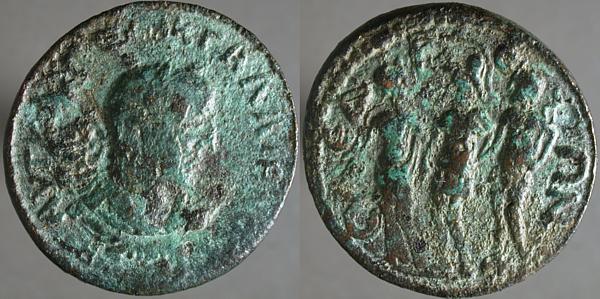
Æ29 from Syedra in Cilicia. ΑΥΤ Κ[ΑΙ ΠΟ ΛΙ]Κ ΓΑΛΛΙΗΝΟC CΕ_Β, Laureate draped cuirassed bust right / CΥ_ΕΔ_Ρ_Ε_ΩΝ, Judgement of Ares: Dike left and Hermes right hold disarmed Ares.
Conundrum with no good solution: buy an interesting coin in less desirable condition, then see a better example for sale a month or two later, or don't buy it and wait for years before seeing another example, and that one less well preserved? Having bought a lower-grade coin and seeing a higher-grade one, buy the upgrade and risk seeing an even better one, or wait for near-perfection? Having upgraded, try to sell the now-unwanted duplicate and take an inevitable loss, hang on to what you no longer want, or try to find enough variation to justify it as something other than a duplicate?
Sunday, November 09, 2003
Silvered Æ antoninianus, Göbl MIR 36, 1317h
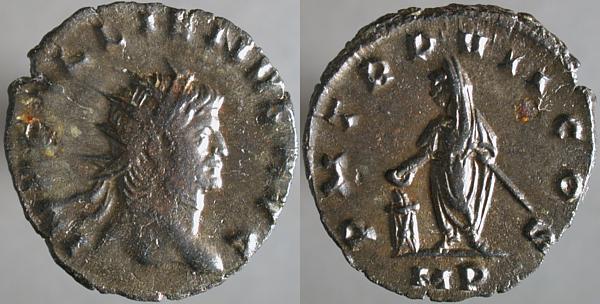
Dated antoninianus, 258-259 CE. IMP GALLIENVS P AVG, Radiate head right, both ribbons behind / P M TR P VII COS, Emperor, veiled, standing facing, head left, holding scepter right, sacrificing from patera over altar left. MP in exergue.
While Romans did count the years from the semi-mythological founding of the city of Rome, they didn't include this information on the coins. Imperial coins were not explicitly dated, but when they show details of imperial titles and honors, as this one does, they can be dated precisely. This coin shows Gallienus as Tribunicia Potestate for the 7th time. Gallienus was made tribune for the 7th time in September 258, and for the 8th time a year later.

